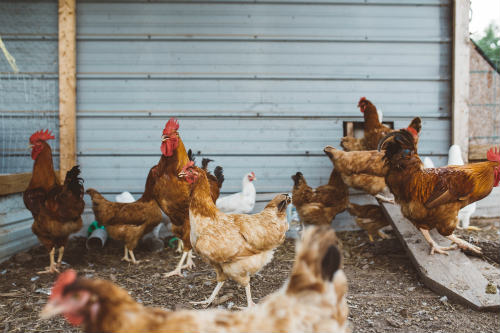As a rule of thumb, if you free-range your chickens, they will need a coop of about 3 to 4 square feet per chicken. If the chickens will be confined to the coop, you’ll need a run of about 10 square feet per bird.
Chickens that are allowed to free range and forage in the yard won’t need much coop space. Because they’ll only need to spend time inside for roosting at night and laying eggs during the day, the interior coop can be quite small. A standard backyard has ample room for free-ranging a small flock of chickens.
If you don’t want to give your chickens access to the whole yard, you’ll either want to fence off a portion of the yard into a run or use a chicken coop with a built in run area. The chicken run should be about 10 square feet per bird.
To put this into practical terms, a flock of 10 chickens that free range will need a 40 square foot coop (4′ x 10′). Without free ranging, a 100 square foot coop and run area would be required (10′ x 10′). For comparison, that is about the size of a standard bedroom in a house.
What Happens if Chickens Don’t Have Enough Space?
Chickens kept in confined quarters will suffer health and behavioral problems. A too-small enclosure will get dirty more quickly, and this can cause the spread of germs and parasites within a flock. Chickens that don’t have enough space to roam and get exercise may become aggressive to one another, leading to fights and injuries or even death.
Keeping chickens in a coop that’s too small can also affect their egg laying. Stressed chickens don’t lay well. They may also begin breaking or eating their own eggs. This will affect the profitability of your small chicken farm as well as the wellbeing of your hens.
The local weather and climate should also be considered when planning your chicken coop. Chickens will need to spend more time indoors when it’s cold than when the weather is mild. If you live in an area with long winters, you’ll probably need more interior space to accommodate your hens as they’ll be spending more time in the coop than if they lived in an area with longer summers and more time to forage around outside.
For the safety and happiness of your chickens, be sure to stick with the minimum space requirements outlined above. Giving your chickens a bit of extra room is always preferable to giving them too little space.
How to Maximize Space in Your Chicken Coop

If you’re free-ranging your chickens during the day, you don’t need an enclosed run. You can merely round up the chickens and put them back in the enclosed coop at night. If you won’t be allowing your chickens to free roam or they won’t have frequent access to the yard, you’ll want to include a chicken run with the coop.
The interior part (plastic or not) of the coop should be sheltered from the elements and include space for roosting as well as nesting. You’ll want one nest box for per three to five chickens. You’ll also need to provide about 8 to 10 inches of perching space for chickens to roost.
In the wild, chickens would roost in trees. Domestic chickens also prefer to roost above-ground even if they’re too heavy to fly. A good chicken perch should be rough enough to hold onto without splintering or causing injuries. A perch should be about 2 inches wide.
You should space perches about 18 inches apart and 18 inches from the wall. You may wish to place the perches at variable heights within the coop to give the chickens plenty of options and ways to hop from lower to higher perches.
Remember to keep the perches at a higher level than nesting boxes to prevent roosting inside the nesting box. Raised perches will also help to keep the coop clean and the birds happy. Hens that have to sleep at ground level may lay fewer eggs and are more likely to lay outside of the nest box.
Space-Efficient Coop Design
Since chickens prefer to roost above-ground, you can get more space from your coop design by putting the enclosed part of your coop at a higher level than the run. Many commercial chicken coops are designed this way.
By lifting the enclosed coop a few feet above ground level, a portion of the chicken run can go underneath the coop. This gives the birds some covered space to run around and forage for bugs or scratch in the dirt without taking up extra square footage. If you’re buying or building a chicken coop, consider this design to maximize space.
What if You Don’t Have Enough Space for Chickens?

Before you start investing in hens, you should assess the amount of space you actually have available and plan your flock around those spatial constraints. You don’t want to buy 10 chickens if you only have space for a 5′ x 5′ coop. Measure your space and get only as many chickens as you can comfortably house.
If you’d like chickens but are cramped for space, a good solution may be to buy a bantam breed. Bantams are smaller than regular chickens and require about half as much space for comfortable housing. They also lay smaller eggs and may not be as prolific, so they are not necessarily as profitable from a farming perspective. If you just want to enjoy the experience of backyard chicken husbandry, however, bantams can be a great choice.
[amazon bestseller=”big chicken coop”]




